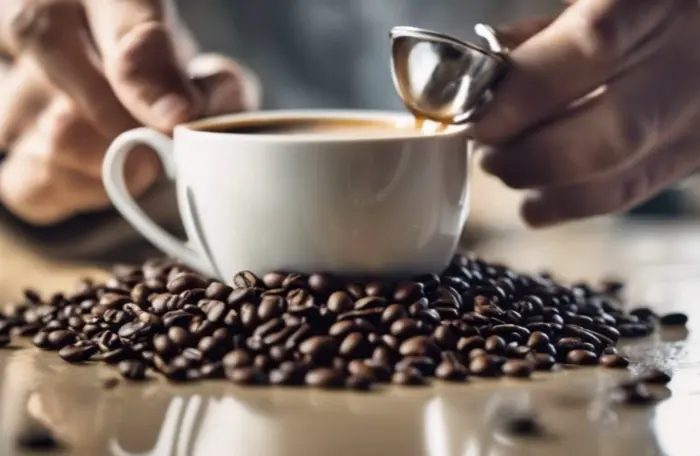Espresso is more than just a strong coffee. It is a concentrated drink brewed by forcing hot water through finely-ground coffee under high pressure. The result is a rich, flavorful shot with a layer of crema on top. But how does this process work? This article breaks down the science, equipment, and techniques behind espresso.
The Basics of Espresso
Espresso is a unique brewing method that differs from drip coffee or French press. The key factors are pressure, grind size, and extraction time.
What Makes Espresso Different?
Regular coffee uses gravity to pull water through coffee grounds. Espresso, however, relies on pressure. A machine forces near-boiling water through tightly packed, finely ground coffee at around 9 bars of pressure. This quick extraction (usually 25-30 seconds) produces a small, intense shot.
The Role of Crema
A well-made espresso has a golden-brown foam called crema. This layer forms when coffee oils emulsify with carbon dioxide released during brewing. Crema adds texture and enhances flavor.
The Espresso Machine: Core Components
An espresso machine is essential for proper extraction. Understanding its parts helps in mastering the brewing process.
The Boiler
The boiler heats water to the ideal temperature (90-96°C or 195-205°F). Some machines have single boilers, while others use dual boilers for better temperature control.
The Portafilter
The portafilter is a handle with a basket that holds the coffee grounds. It locks into the machine, allowing pressurized water to pass through.
The Pump
The pump creates pressure, typically around 9 bars. There are two types: vibratory pumps (common in home machines) and rotary pumps (found in commercial models).
The Group Head
This is where the portafilter attaches. It distributes water evenly over the coffee puck for uniform extraction.
The Espresso Brewing Process
Making espresso involves precise steps. Even small mistakes can ruin the shot.
Step 1: Grinding the Coffee
Espresso requires a fine, consistent grind. If the grind is too coarse, water flows too fast, producing a weak shot. If too fine, it can cause over-extraction and bitterness.
Step 2: Dosing & Tamping
The ground coffee is dosed (measured) into the portafilter. A standard double shot uses 18-20 grams. After dosing, the coffee is tamped—compressed evenly to ensure proper water flow.
Step 3: Locking In & Starting the Shot
The portafilter is locked into the group head. The machine is activated, forcing hot water through the coffee. Extraction should take 25-30 seconds for a balanced shot.
Step 4: Observing the Extraction
A good espresso shot starts with a slow drip, thickens into a steady stream, and ends with a blonding phase (when the flow turns lighter). Stopping the shot at the right time is crucial.
Variables That Affect Espresso Quality
Several factors influence the final taste. Adjusting these can help perfect the brew.
Coffee Bean Selection
Fresh, high-quality beans are essential. Espresso blends often contain a mix of Arabica and Robusta for balance. The roast level (usually medium to dark) impacts flavor intensity.
Water Temperature
Too hot, and the coffee tastes burnt. Too cool, and it under-extracts, tasting sour. Most machines maintain a stable temperature, but some allow manual adjustments.
Pressure & Flow Rate
Proper pressure ensures even extraction. Too much pressure can cause channeling (water finding weak spots in the puck), leading to uneven flavor.
Extraction Time
Under-extraction (too fast) makes sour, weak espresso. Over-extraction (too slow) results in bitterness. The ideal range is 25-30 seconds.
Common Espresso Problems & Fixes
Even experts face issues. Here’s how to troubleshoot.
Sour Espresso
This usually means under-extraction. Try a finer grind, higher dose, or longer extraction time.
Bitter Espresso
Over-extraction is the likely cause. Use a coarser grind, lower dose, or shorten the shot time.
No Crema
Old beans, incorrect grind size, or low pressure may be the issue. Use fresh coffee and check machine pressure.
Channeling
If water bypasses parts of the puck, the shot tastes uneven. Ensure even tamping and proper grind size.
Advanced Espresso Techniques
Once basics are mastered, baristas experiment for better results.
Pre-Infusion
Some machines wet the grounds lightly before full pressure. This helps even extraction.
Pressure Profiling
High-end machines allow adjusting pressure during extraction. This can enhance sweetness or acidity.
Single-Origin Espresso
Instead of blends, some use single-origin beans for unique flavors. This requires careful adjustment of grind and dose.
Espresso-Based Drinks
Espresso is the base for many popular drinks.
Cappuccino
Equal parts espresso, steamed milk, and foam.
Latte
More milk than a cappuccino, with a light foam layer.
Americano
Espresso diluted with hot water for a milder taste.
Macchiato
Espresso “stained” with a small amount of milk or foam.
Maintaining Your Espresso Machine
Proper care ensures longevity and consistent quality.
Daily Cleaning
Flush the group head after each use. Wipe the portafilter and steam wand.
Weekly Backflushing
For machines with a three-way valve, backflushing with water or cleaner removes coffee oils.
Descaling
Mineral buildup affects performance. Descale every few months, depending on water hardness.
Conclusion
Espresso is a science and an art. It requires the right equipment, fresh coffee, and precise technique. By understanding pressure, extraction, and variables like grind size, anyone can master espresso. Whether enjoyed alone or in a milk-based drink, a well-made espresso is a rewarding experience. This guide covers the essentials, but practice is key. Experiment, adjust, and enjoy the process of brewing the perfect shot.
Related topics:
How Long to Pull a Double Shot of Espresso
Buon Giorno Coffee: A Journey to Exceptional Espresso & Beyond
Where to Buy Gaggia Espresso Machines: A Complete Guide


